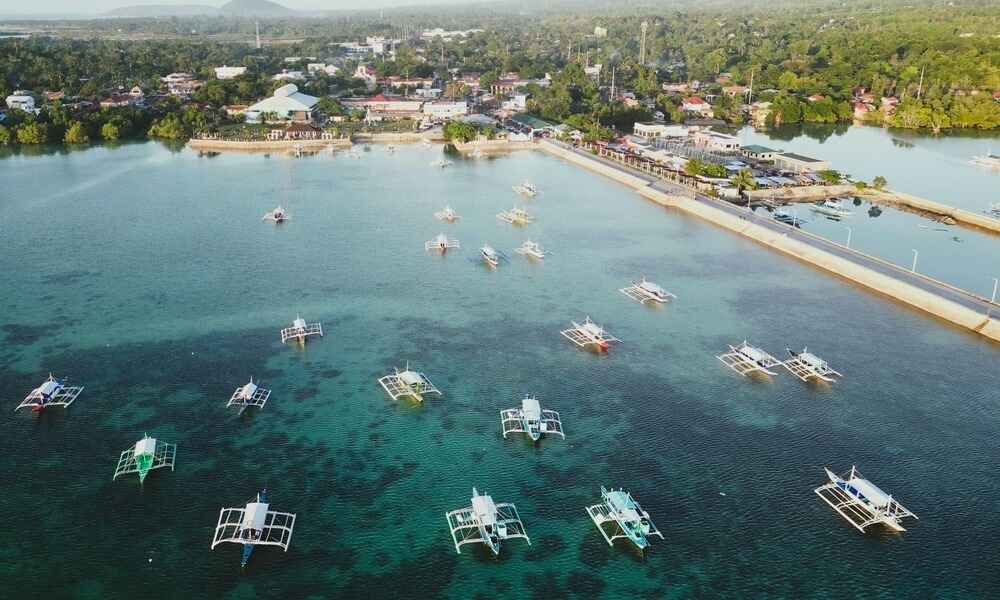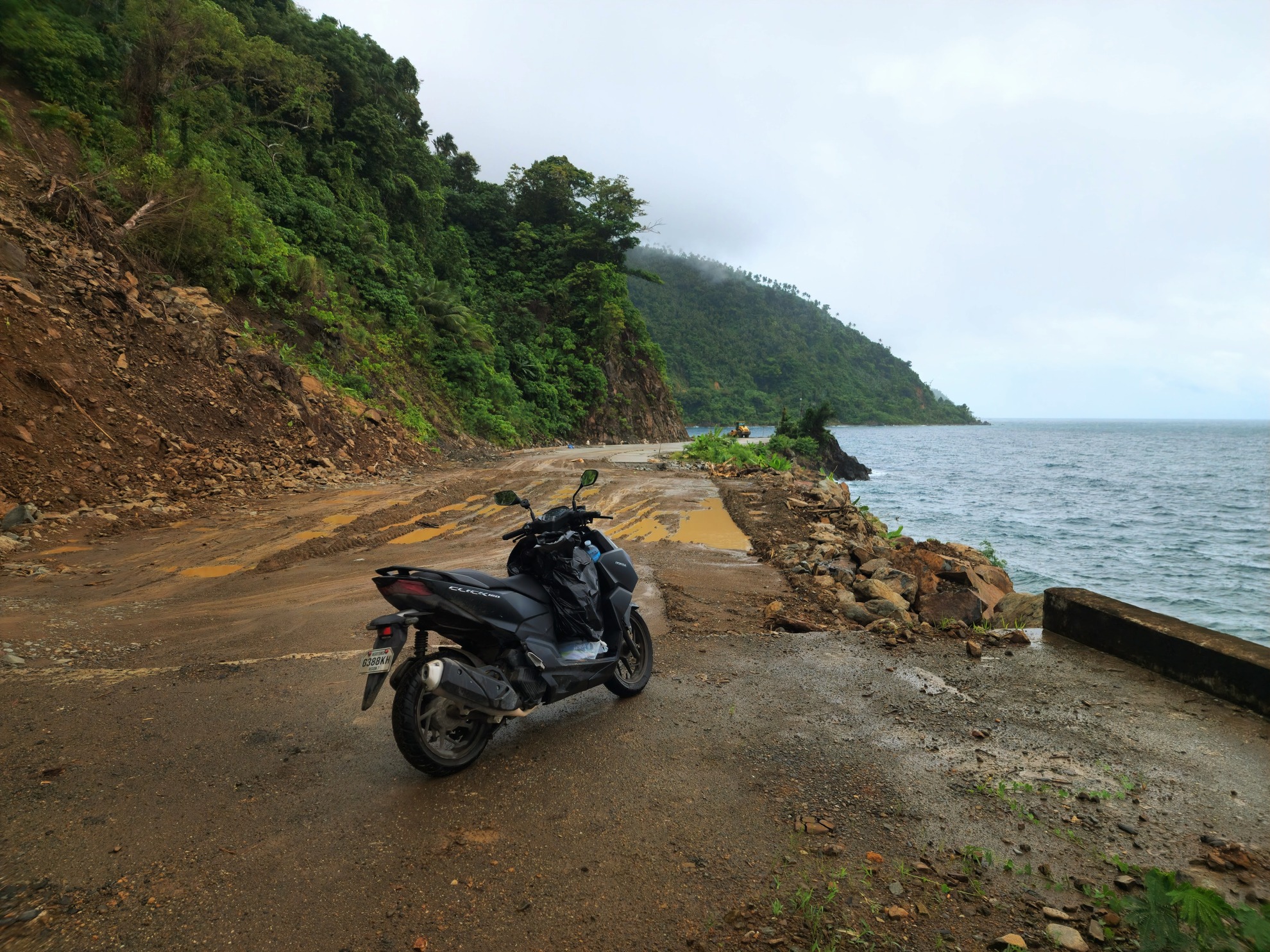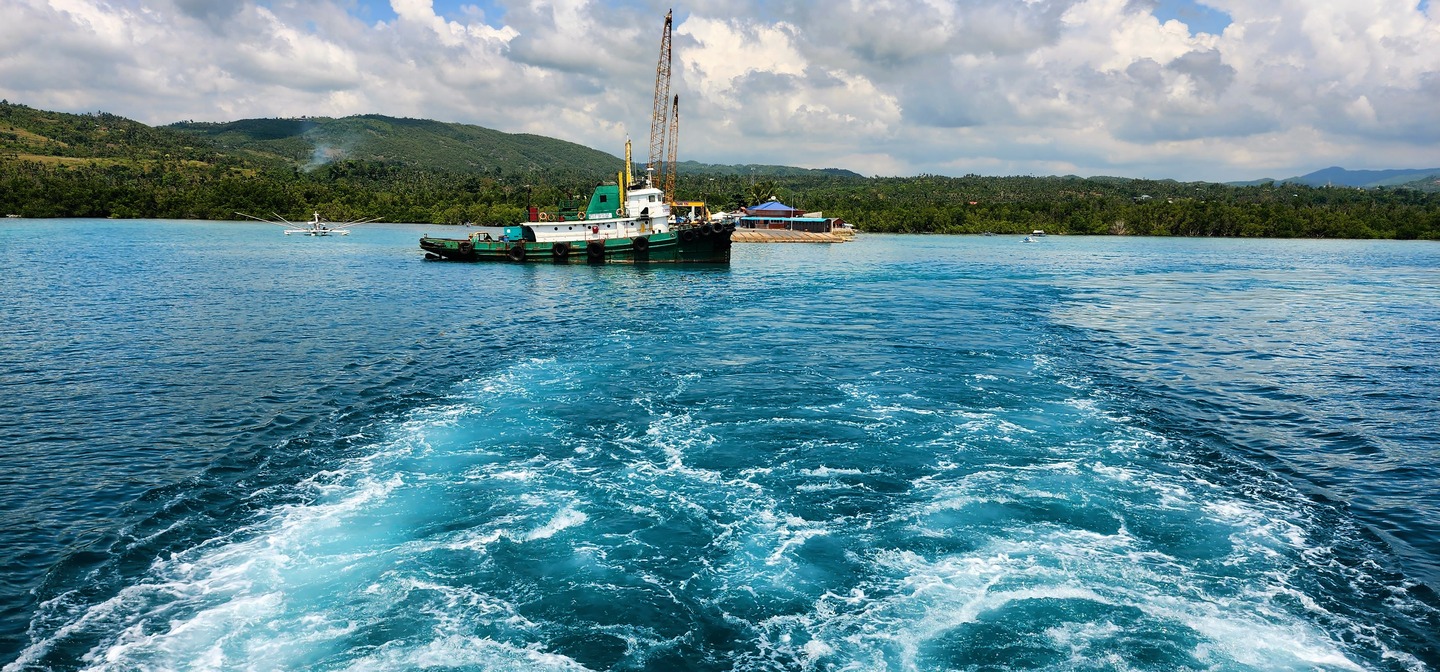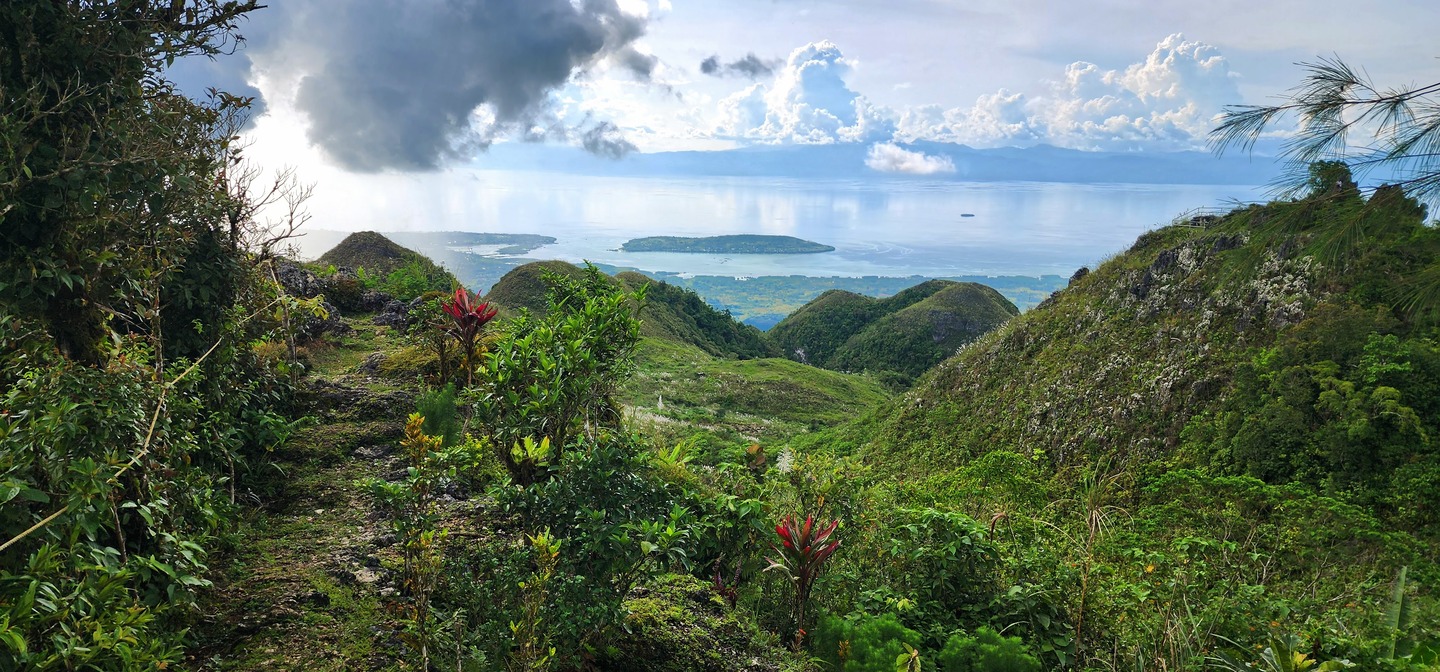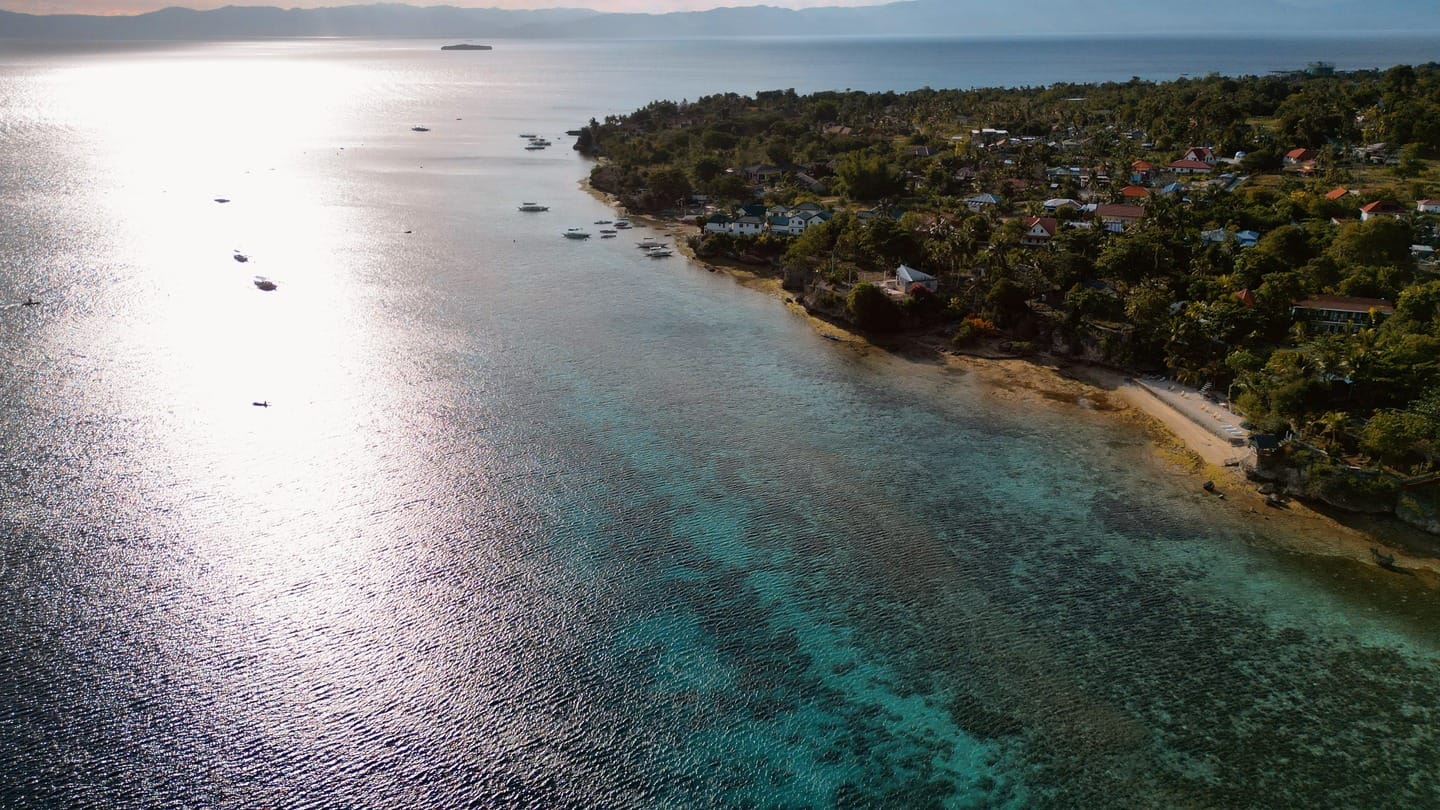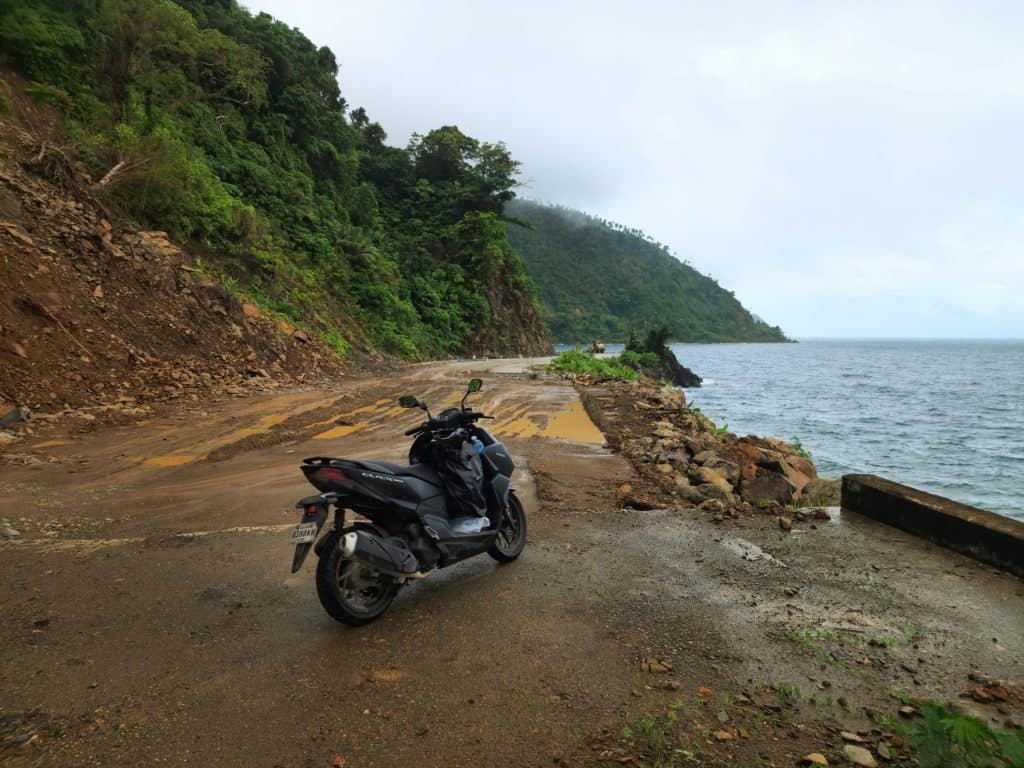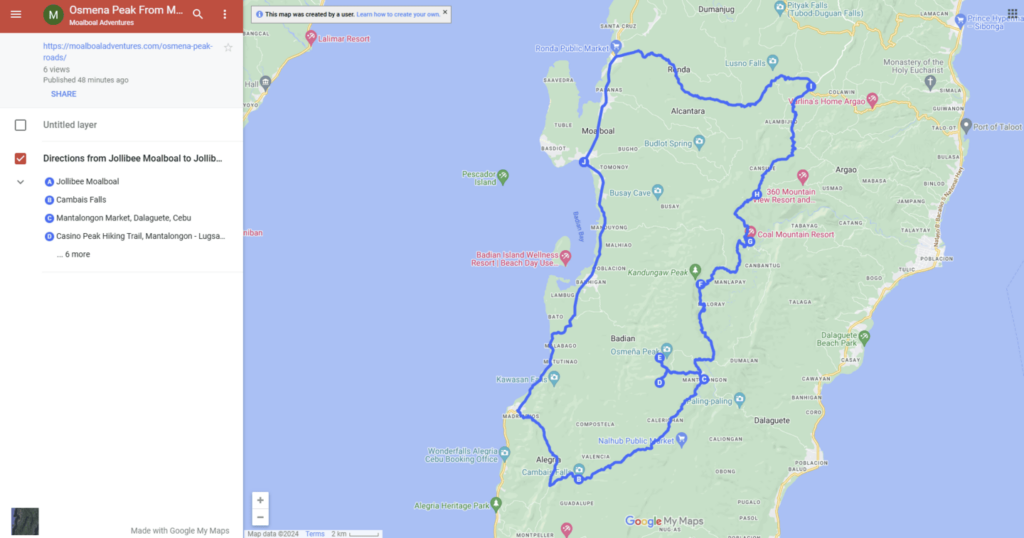Cebu, situated in the Visayas region of the Philippines, is a prominent island with Negros Island lying just across the Tanon Strait to the west. The largest city in Cebu is Cebu City, often referred to as the Queen City of the South holds a rich history and cultural heritage.
Cebu is renowned as the site of the oldest Spanish settlement in the Philippines. In 1565, the Spanish explorer Miguel Lopez de Legazpi, alongside his men, established the Santissimo Nombre de Jesus and laid the foundations for what is now Colon Street in Cebu City. This marked the beginning of Spanish influence in the archipelago.
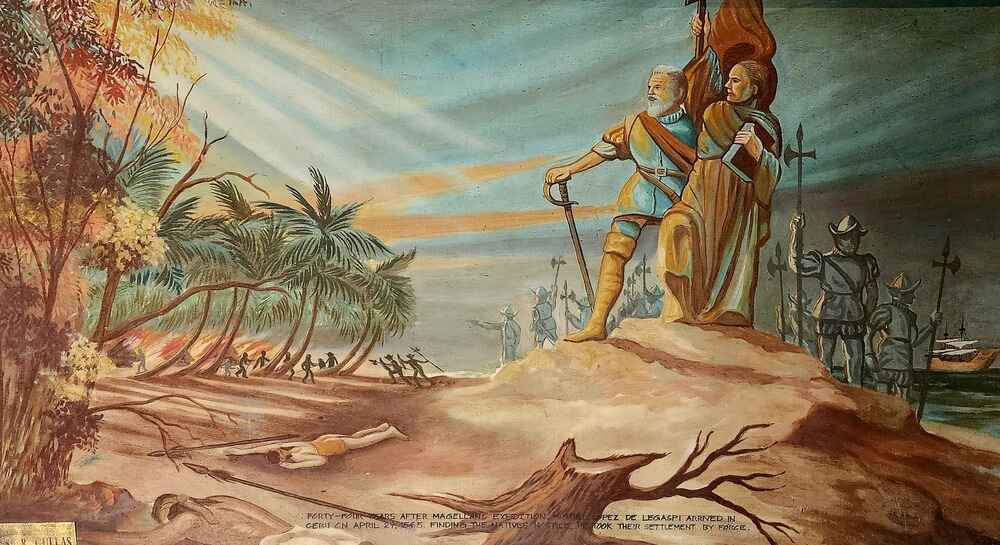
THE ARRIVAL OF MIGUEL LOPEZ DE LEGAZPI AND FRAY ANDRES DE URDANETA,O.S.A – On April 27, 1565, Miguel López de Legazpi’s expedition returned to Cebu. Rajah Tupas did challenge the Spanish presence. The Spaniards ultimately prevailed in an encounter and established a settlement they named “Villa del Santisimo Nombre de Jesús” (Town of the Most Holy Name of Jesus) after finding a religious image (Sto. Niño) in a local house.
Earlier in 1521, Ferdinand Magellan, a Portuguese explorer in the service of the Spanish Crown and leader of the inaugural expedition to circumnavigate the globe, arrived in Cebu. However, his journey was cut short when he encountered resistance from the local chieftain Lapu-Lapu in nearby Mactan Island, where Magellan met his unfortunate demise. It took over two decades for the Spanish conquistadores to return and officially claim the islands for the Spanish throne.
Cebu City has transformed into a modern metropolis and stands as the Philippines’ second-largest city, boasting the largest seaport and the second-largest air hub in the country. It holds the distinction of being the fastest-growing large city in the nation, experiencing an annual growth rate of over 8%. The city combines the conveniences of a contemporary urban center with abundant natural resources, including numerous white sand beaches—both commercial and untouched—and historical sites that reflect its cosmopolitan past, from the advent of Christianity in Asia to early commercial trade with Mexico and China, and remnants of American colonization.
With dreams of spice riches and a westward route, Ferdinand Magellan embarked on his ambitious circumnavigation in 1519, leading 270 men aboard five ships: Trinidad, San Antonio, Concepción, Victoria, and Santiago. Their arduous journey, however, was fraught with hardship. Battles, starvation, and the ever-present threat of scurvy whittled down their numbers. By the time they reached the verdant shores of the Philippines in 1521, their initial dreams had morphed into a desperate struggle for survival.
Their encounter with the archipelago unfolded like a dramatic saga. First making contact with the people of Guam to replenish their supplies, they then sailed to Cebu Island, where Magellan’s diplomatic prowess secured an alliance with the local ruler, Rajah Humabon. Impressed by the display of Spanish weaponry and convinced of their superiority, Humabon converted to Christianity, along with many of his subjects. A baptism officiated by Magellan himself marked this momentous occasion.
However, ambition often breeds its own demons. Emboldened by Humabon’s alliance, Magellan sought to conquer the neighboring island of Mactan, ruled by the defiant Lapu-Lapu. Underestimating Lapu-Lapu’s forces and the ferocity of their resistance, Magellan met his end in the ensuing Battle of Mactan. Though his death marked the tragic culmination of his personal journey, his crew persevered. Leaving two ships behind, they pressed on, their spirits buoyed by the hope of reaching the Spice Islands.
Their tenacity paid off. They eventually reached their goal, laden with precious cloves before embarking on the final leg of their voyage. Only 18 men and a single ship, the Victoria, managed to complete the first circumnavigation of the world, forever etching their names in history. Though Magellan never saw Spain again, his daring voyage, born in Portugal, forever linked its destiny with the Philippines. It paved the way for centuries of Spanish colonial influence and cultural exchange, leaving an indelible mark on the archipelago’s history and shaping its cultural tapestry to this day.
About Moalboal
Nestled within the province of Cebu, Moalboal town stands as a 4th class municipality, a captivating blend of natural wonders and cultural heritage. With a population of 36,960 according to the 2020 census, this enchanting town extends like a peninsula on the southwestern edge of Cebu, bordered by the picturesque Tañon Strait and offering glimpses of Negros Island from its western shoreline. Located 89 kilometers (55 miles) away from bustling Cebu City, Moalboal town is easily accessible, requiring approximately 3 to 4 hours by public bus.
UNVEILING THE ORIGINS
Moalboal’s name carries a historical resonance, its etymology rooted in two fascinating versions. One suggests a connection to the bubbling sounds, known as “bocalbocal” or “bukalbukal” in Cebuano, emanating from a local spring. The other links the name to the town’s early settlers, believed to be Boholanos or Bol-anons, with time transforming these influences into the unique identity of “Moalboal.”
Historical nuances are discovered in old spellings such as “Moalbual” and “Mualbual,” offering intriguing glimpses into the town’s linguistic evolution.
DYNAMIC DEMOGRAPHICS
While Cebuanos form the majority of Moalboal’s population, the town has become a melting pot, welcoming members of cultural minorities. Notably, the Bajaus, reminiscent of Muslim nomads, occasionally grace the streets during holiday seasons, contributing to the town’s cultural diversity.
ECONOMIC LANDSCAPE
Industry and Trade: Moalboal’s unique geography, surrounded by water as a peninsula, guides its economic pursuits. Flatland residents primarily engage in fishing, while those in mountainous regions, such as Agbalanga and Bala, find their livelihoods through agriculture.
TOURISM THRIVES
Panagsama Beach, integral to Moalboal’s tourism since the 1970s, beckons with untouched coastal allure, focusing on recreational diving. A hub for adventure enthusiasts, this locale features resorts and dining options. The captivating sardine run at Panagsama Beach offers snorkelers a mesmerizing experience, where the possibility of encountering sea turtles adds an extra thrill to the exploration.
White Beach (Basdako): Further north lies the captivating White Beach in Saavedra, spanning two kilometers and now attracting international tourists, though initially cherished by locals.
Beyond the shores, Moalboal serves as a gateway for exhilarating adventures in southern Cebu. Dive into canyoneering in Badian and Alegria, experiencing the famous Kawasan Falls excursion. Discover numerous waterfalls and soak in scenic views through mountain rides. Scale peaks like Osmena, Casino and Kandungaw for panoramic vistas of Badian Island and Moalboal, enhancing the charm of this adventure-filled destination.
Banks, ATM and Money Exchange
Most local banks, including those within Moalboal, tack on a 250 pesos surcharge for ATM withdrawals using overseas bank cards, setting a transaction cap at 10,000 pesos. However, a potential money-saving alternative exists in Cebu City at the HSBC ATM, which welcomes most foreign cards and allows transactions up to 40,000 pesos, free of transaction fees. Withdrawing funds here before your Moalboal adventure could be a prudent move.
If you find yourself at Panagsama Beach, an accessible PNB Visa card ATM awaits you at the entrance of Eve’s Kiosk. Meanwhile, in Moalboal town, around 3.5 km from the beach and reachable by tricycle, the 360 Pharmacy hosts a Metro Bank ATM, catering to Mastercard. Further options include a PNB Bank with an ATM at Gaisano Town Center Mall and a Metro Bank ATM at Gaisano Grand (accepting both Visa and Mastercard). Another ATM is conveniently located outside of the 7-Eleven store and the Municipal Hall. ATMs may experience limitations on Sundays, often running low on cash.
When withdrawing cash abroad from foreign ATMs, you may encounter the option to ‘Accept Conversion’ or ‘Decline Conversion.’ Here’s what it means:
Accept Conversion: Opting for this means you agree to withdraw money at the exchange rate set by the ATM. However, be aware that these rates often include ‘hidden’ fees, making them considerably higher (usually 5%-15%).
Decline Conversion: Choosing this option indicates that you prefer to withdraw money at the exchange rate set by your card issuer, whether it’s Visa, Mastercard, Amex, or another logo on your card. This can help you save on fees.
Remember, similar prompts on ATMs might use phrases like ‘With Conversion’ or ‘Without Conversion.’ Therefore, selecting ‘Decline’ ensures a more favorable exchange rate and cost-effective transaction.”
Encountering an option to be charged in your home currency, known as Dynamic Currency Conversion (DCC), may arise during withdrawals. It’s advisable to steer clear of this option for optimal savings. To secure the best exchange rate, consistently opt to be charged in the local currency when withdrawing money.
ATMs in the Philippines:
ATMs are readily accessible in urban centers, particularly within banks and shopping malls. However, locating one outside of these metropolitan areas can be challenging. Utilize the following tools to identify the nearest ATM:
When taking the bus from Cebu City’s South Bus Terminal, consider visiting Alchor Forex Money Changer on the second floor of City Mall next door to the terminal or the third floor of Elizabeth Mall for competitive currency exchange rates. For the most favorable rates on Euros, it is recommended to visit the Core Pacific Money Exchange on the third floor of Elizabeth Mall.
In Moalboal, you can only exchange money at the Gaisano Grand Mall and Palawan Pawnshop. Ensure you have your passport with you, and your currency notes are in pristine condition.
Supermarkets And Wet Market
Moalboal offers two Gaisano malls, Operating from 9:00 AM to 7:00 PM
Gaisano Town Center Mall is around 1 kilometer away It has a quieter supermarket and a special section with imported goods and hardware section. Upstairs, you’ll find a store with sports, beach stuff, household goods, souvenirs, and a clothes department. Outside, there’s an ATM a pizza shop, and a BVL beauty salon. There is ample parking available in front of the mall.
Gaisano Grand Mall, situated along Barili-Toledo Road. Upstairs of Gaisano town center mall is the department store for clothes, home goods, and kids’ toys. Outside the mall, there’s a McDonald’s, a PNB bank with an ATM, a computer, and a phone shop. During inclement weather, you have the option to park your vehicle either inside the garage area or in front of the mall.
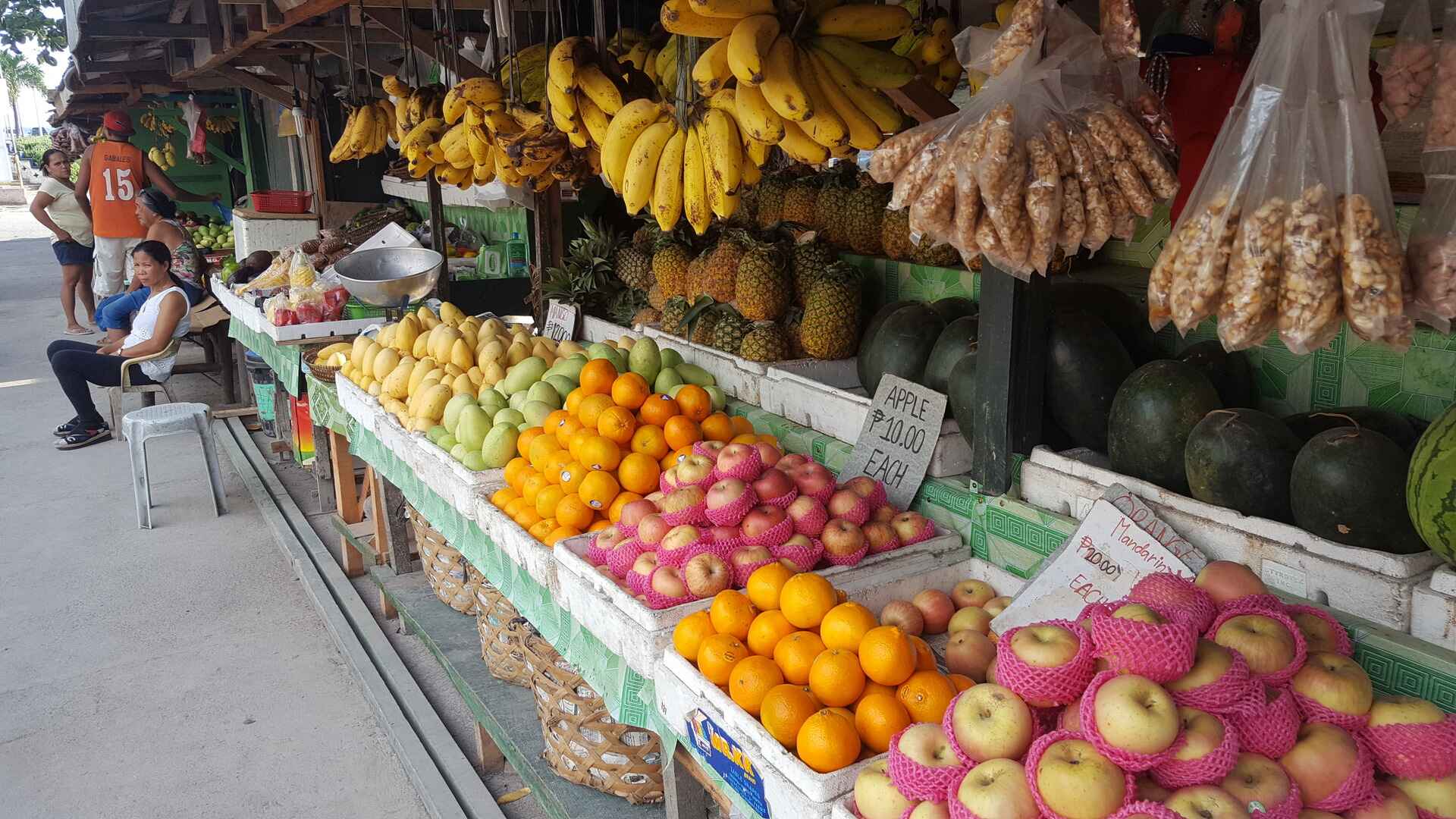
Vibrant fruit stands line the sidewalks, adorned with an array of tropical delights like ripe mangoes, pineapples, and juicy watermelons, enticing passersby with their colorful displays and fragrant aromas.
This is an excellent place to buy tropical fruit, mostly fresh, and the prices are reasonable.
Moalboal Public Market: Hours 5:00 AM – 7:00 PM
Numerous independent vendors offer a diverse range of products. This area used to be the primary source for locals to purchase food, clothing, and household items before the advent of malls.
A diverse array of fish and seafood is available from numerous vendors, accompanied by options for chicken and pork. However, beef is scarce here; one must venture to either of the two modest malls to find it. The freshness of all the seafood and meat is quite apparent. It’s essential to note that this is a “wet market,” lacking cold cases and with minimal ice.
For better selection and more competitive prices, consider making the 10-kilometer drive to Badian Public Market from Moalboal. There, you’ll likely find a broader range of products to choose from.
During the weekends, farmers from the mountains visit Moalboal to sell their fresh produce. This period is a treasure trove for budget-conscious shoppers, as these farmers typically offer their goods at affordable prices. For me, it’s the prime time to shop for produce in Moalboal. They set up temporary tables in the alleys, covered with tarps for sun protection.
I have a preference for buying from elderly vendors, many of whom are hardworking farmers. They travel down from the mountains to share the fruits of their labor. Choosing to purchase from these vendors is my small way of extending help to these dedicated individuals, contributing to their livelihoods while enjoying the freshest and most authentic local produce.
Ideal Time To Visit Moalboal Based On The Weather
Moalboal has a tropical climate with warm temperatures year-round. Here’s a breakdown of what you can expect each month:
Temperature:
Average high: 29-32 °C (84-90 °F)
Average low: 22-25 °C (72-77 °F)
Rainfall:
Varies throughout the year, with the wettest months being May to October (averaging over 120 mm or 4.7 inches) and the driest months February to April (averaging under 50 mm or 2 inches).
Most rainy days occur between April and October (averaging over 10 days per month).
Here’s a simplified table for quick reference:
| Month | Average High (°C) | Average High (°F) | Average Rain (mm) | Average Rain (in) | Rainy Days |
|---|---|---|---|---|---|
| Jan | 29 | 84 | 42 | 1.7 | 10 |
| Feb | 30 | 86 | 34 | 1.3 | 9 |
| Mar | 31 | 88 | 40 | 1.6 | 10 |
| Apr | 32 | 90 | 61 | 2.4 | 13 |
| May | 31 | 88 | 124 | 4.9 | 22 |
| Jun | 30 | 86 | 188 | 7.4 | 27 |
| Jul | 30 | 86 | 190 | 7.5 | 28 |
| Aug | 30 | 86 | 191 | 7.5 | 28 |
| Sep | 30 | 86 | 189 | 7.4 | 27 |
| Oct | 29 | 84 | 186 | 7.3 | 28 |
| Nov | 29 | 84 | 124 | 4.9 | 21 |
| Dec | 29 | 84 | 73 | 2.9 | 13 |
Overall: Great weather for enjoying the outdoors year-round! Be prepared for occasional rain showers, especially during the wet season.
Note: While this overview provides general trends, always check real-time forecasts closer to your travel dates for the most accurate information.
Medical Facilities & Pharmacies
Established in 1909, Chong Hua Hospital stands as a beacon of cutting-edge healthcare, centrally positioned at Fuente Osmeña Circle in Cebu, with an additional branch in Mandaue. Among Cebu City’s array of hospitals, Chung Hua, known for its prominence and established reputation, recommends its Manduay facility for most cases. Given the likelihood of medical bills accumulating swiftly, it is prudent to secure a suitable travel insurance policy for comprehensive coverage.
Cebu Doctors’ University Hospital stands as a unique blend of a medical tertiary education institution and a comprehensive healthcare provider. This establishment offers aspiring doctors and medical practitioners an immersive experience, enabling in-depth study and research in a real-world setting under the mentorship of seasoned professionals. Much like Chong Hua Hospital, it boasts top-notch facilities and a rich history while steadfastly pursuing its vision and mission of delivering high-quality healthcare.
In Moalboal, various doctors are available to address minor health concerns, ranging from colds to providing stitches and dressing small wounds. However, for more severe conditions, a visit to the city is usually warranted.
Dr.Irish Sarmiento Clinic (pediatric)
Cebu Provincial Hospital-Carcar City
Pharmacies
Rose Pharmacy Gaisano Grand Mall
Health and Safety in Moalboal
When traveling in the Philippines, including Moalboal, it’s natural to have concerns about health, sanitation, and water safety. Here’s what you should know:
Water Safety
Moalboal sources its water from multiple natural springs and deep wells, with Budlot Spring in Barangay Bala being a primary and vital source, supplying treated water to over 8,600 households through a comprehensive pipeline system. Other significant sources include Pangi Spring, which has faced occasional contamination issues, and Busay Spring, known for its clean, potable water and used as an alternative supply when needed. The municipality also relies on deep wells, such as the Bugho Deep Well Project, capable of producing 345 cubic meters per day, and several others developed to address water shortages.
While tap water is generally safe for brushing your teeth, it is advisable to drink only bottled water or water treated by certified facilities. This is a common recommendation throughout the Philippines to avoid any potential health issues.
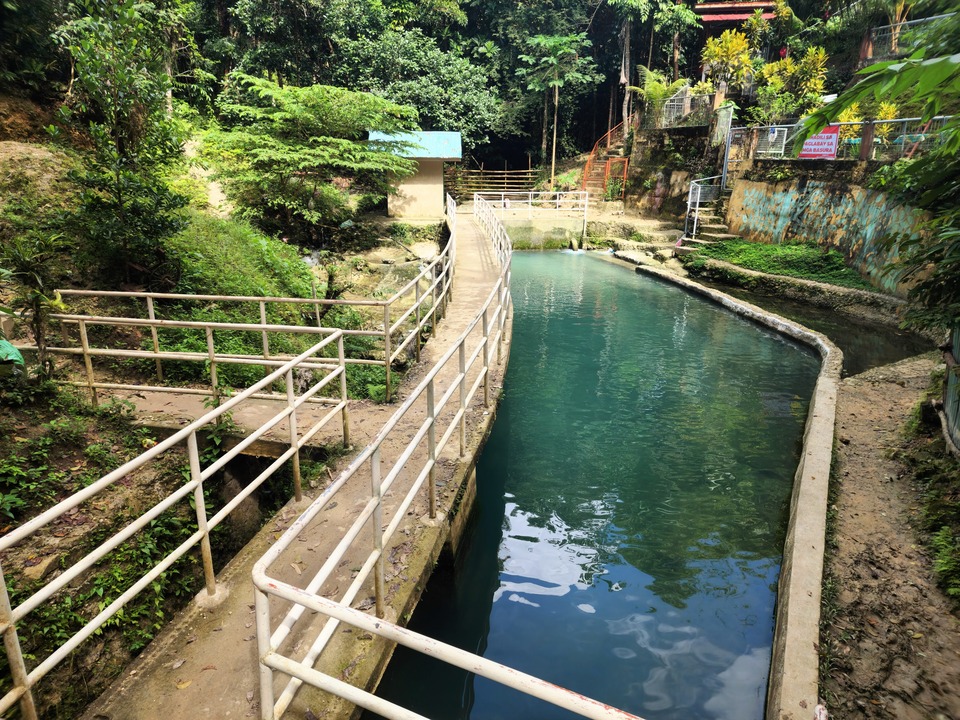
Mosquito-Borne Diseases
The Philippines, including Cebu, is not a malarial zone, so anti-malaria measures are unnecessary. However, mosquitoes can be particularly active at dusk, and dengue fever is a risk that tends to follow periodic cycles. Protect yourself by using mosquito repellents such as “Off” or natural citronella-based products.
Vaccinations
As with most destinations in Asia, it’s important to ensure your routine vaccinations are up-to-date. For travel in the Philippines, it’s recommended to have vaccinations for Hepatitis A and B, Typhoid, Tetanus, and Polio. While not mandatory, a Rabies vaccination is worth considering if you plan to visit remote areas or stay for an extended period.
Safety in Moalboal
Moalboal is generally considered safe for tourists, with crime rates being lower than in larger cities. However, as in any destination, it’s wise to take standard precautions to ensure your safety.
Moalboal Emergency Numbers
Disaster Risk Reduction and Management: (0908) 285 0313.
For police assistance: (0932) 955 1738 or (032) 474 8205.
Fire Station: (0917) 654 3646
Rural Health Unit: (032) 474 0014
Philippine Coast Guard: (0915) 490 9152
Municipal Tourism Office: (032) 474 8323
The Moalboal Post Office is conveniently situated on the ground floor of the Municipal Hall. As you enter the building, take the first left, and you’ll find the post office. Ample parking space is available in front of the municipality. Public restrooms are available in the Municipal Hall for added convenience.
Moalboal Municipal Police Station
Moalboal Tourist Information Center and Tourist Pass
Moalboal Seaside Park – is an excellent place to relax, featuring vendors offering snacks and drinks. Moalboalanons regularly gather at the park to enjoy the nightly free movie screenings, making it a popular spot for community entertainment.
Parking in Panagsama
If you’re arriving by car to Panagsama, parking options are limited if you’re not parking at your hotel. However, there are two public paid parking areas available. One is situated next to Venz Kitchen, and the other is near Veranda restaurant. Simply turn right onto that street, and you’ll find a public parking lot about 30 meters ahead on the right side.
Power Outlets and Adapters
The Philippines uses a mix of power outlet types, so being prepared with the right adapter is important for travelers. Here’s a rundown:
Outlet Types:
- Type A (North American Standard): Two flat parallel pins, common in the US and Canada.
- Type B (US with Grounding Pin): Two flat parallel pins with a round grounding pin, also found in North America.
Voltage:
- Philippines: 220 volts (V) at 60 Hertz (Hz)
- Europe: Most countries use 230V at 50Hz, with some variations.
- USA: 120V at 60Hz
Many electronic devices these days, especially laptops and cellphones, are built to handle a range of voltages. This is because they have a built-in transformer that converts the incoming AC (Alternating Current) electricity to the lower DC (Direct Current) voltage they need to function.
Laptops and cellphones often only need an adapter, not a converter. You can find adapters in many stores for a reasonable price, like 50 pesos.
Devices that might require a voltage converter in the Philippines (220V) even if you’re coming from a country with lower voltage (e.g., 110V in the USA):
- High-wattage appliances: Hair dryers, curling irons, straighteners, electric kettles, toasters, and coffee makers often have a higher wattage rating (measured in Watts). Since wattage is a product of voltage and current, a higher wattage appliance might need a converter to adjust for the different voltage and maintain proper functionality. Their simpler internal design might not have built-in transformers for a wide voltage range.
- Travel appliances: Some shavers, electric toothbrushes, and hair clippers specifically designed for travel might be dual voltage, but others might be built for the voltage of the region they’re sold in. Check the label carefully.
- Medical devices: Equipment like CPAP machines or nebulizers are crucial for some travelers. Double-check the voltage requirements and consult a healthcare professional before using them with just an adapter.
Here’s a general rule of thumb:
- Low wattage devices with a power brick (charger): Laptops, phones, tablets, cameras (usually under 100 watts) often have a power brick that does the voltage conversion and just need an adapter for the plug type.
- High wattage devices without a power brick: Appliances like hair dryers, kettles, toasters (often above 100 watts) might need a voltage converter to adjust for the different voltage in the Philippines.
If you’re moving to the Philippines or staying for a prolonged period, investing in an AVR (Automatic Voltage Regulator) is a smart decision to protect your electronics. Here’s why:
What is Dirty Power?
Dirty power is electricity that deviates from the ideal voltage or has inconsistencies like surges, spikes, and dips. These variations can damage or shorten the lifespan of your electronics. Here’s how:
- Voltage Fluctuations: Appliances are designed for a specific voltage range. Frequent surges (voltage spikes above normal) or dips (voltage drops below normal) can stress components and lead to premature failure.
- Power Surges: Lightning strikes or sudden changes in power demand on the grid can cause surges. These high-voltage spikes can fry circuits and permanently damage equipment.
How Does an AVR Help?
An AVR acts as a middleman between your device and the wall outlet. It continuously monitors the incoming voltage and adjusts it up or down to maintain a safe and consistent level for your appliance. Here’s how it protects your electronics:
- Voltage Regulation: During minor fluctuations, the AVR regulates the voltage to a level within the safe operating range for your device.
- Surge Protection: Many AVRs incorporate surge suppression circuitry that absorbs excess voltage spikes, safeguarding your equipment from sudden jolts.
Benefits of Using an AVR:
- Protects Investment: Extends the lifespan of your valuable electronics by shielding them from dirty power.
- Prevents Data Loss: Safeguards against sudden shutdowns or malfunctions that could cause data loss on computers and other devices.
- Peace of Mind: Provides peace of mind knowing your appliances are protected from unexpected power fluctuations.
While an AVR is a great defense against dirty power, it’s important to note that it doesn’t protect against everything. Extremely large power surges or direct lightning strikes might still cause damage. However, for the everyday fluctuations and surges common in the Philippines, an AVR is a valuable tool to keep your electronics safe.
There are two main AVRs: relay-type and servo-motor type.
- Relay-type: Affordable, good for basic protection, slower response, less precise.
- Servo-motor: Faster, more precise, ideal for sensitive electronics, but pricier.
Choose based on your needs: basic protection or sensitive electronics? Affordability or precision?
Relay-type of AVRs (Automatic Voltage Regulators) further divide to:
- AVR with UPS: This type combines an AVR with a UPS (Uninterruptible Power Supply) function. It regulates incoming voltage and also provides temporary battery backup during power outages, allowing for a safe shutdown or continued operation of your devices.
- AVR without UPS: This is a simpler AVR that focuses solely on voltage regulation. It protects your electronics from surges, dips, and fluctuations in the power supply, but doesn’t offer backup power in case of an outage.
I own and suggest an APC AVR, with the basic model priced around 1200 pesos on Lazada or at most electronic shops in malls.
